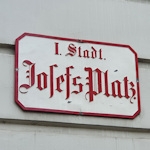
Ah, one of those central Viennese squares where every building on it counts as “historical”. Although relatively small, Josefsplatz manages to feature a palace, an ancient church and perhaps Vienna’s greatest Baroque jewel among its surrounds.
- Home to the national library, Hofburg palace buildings & the Augustinerkirche
- Named after Emperor Joseph II
- A star of the The Third Man movie
- Book a historical walking tour* for your visit
- See also:
History and buildings
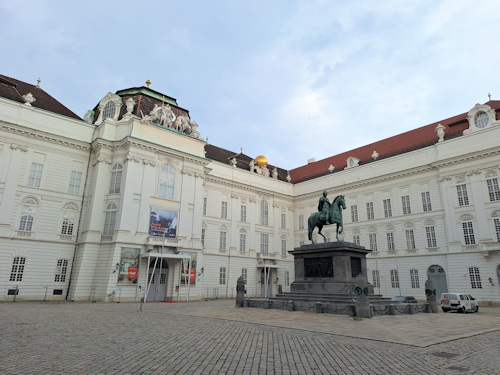
(The view from Augustinerstraße)
Remarkably, this open space in the very centre of Vienna has been an open space for a rather long time. No doubt the graveyard of the nearby medieval church (see below) would have encroached on the area.
A map of the city from as far back as 1547 clearly shows today’s Josefsplatz marked in green and labeled as containing a maze. By this time, the land had been absorbed into the main Habsburg residence (the Hofburg complex).
What you see now is more or less what the square looked like from around the 1780s:
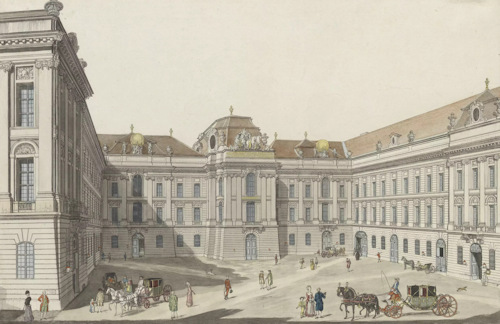
(View of Josefsplatz and the Imperial court library published in 1780 by Artaria & Co. Verlag using artwork by Carl Schütz. Note the absence of the central monument, which arrived a few years later; Wien Museum Inv.-Nr. 18971; excerpt reproduced with permission under the terms of the CC0 licence)
Let us take a tour of the main features and buildings…
The Monument
The emperor at the time when Josefsplatz reached its final form was Joseph II, which explains the name (albeit with idiosyncratic spelling).
Joseph himself dominates the centre of the square with a monument in his honour, completed in 1807 just a few years after his 1790 death.
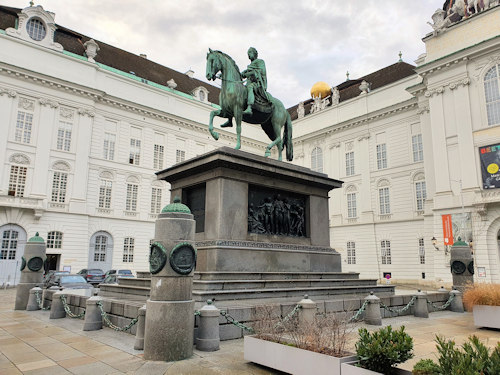
(The reliefs on the surrounding columns document milestones and achievements in Joseph’s life and reign)
If the design seems familiar, that might be because it mirrors the famous equestrian statue of Marcus Aurelius in Rome.
Joseph II stretches out the same right arm as his Roman predecessor and the horse even has the same leg raised as in the original.
History regards Joseph II relatively well, seeing him as one of the more enlightened monarchs in the European timeline. For example, his tolerance of religions outside of Catholicism even had the Pope drop by to try and persuade him otherwise.
Augustinerkirche
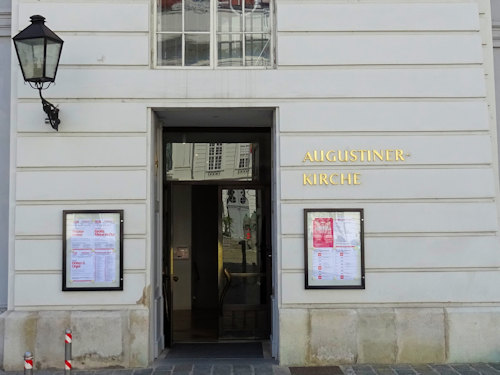
(Look for the remarkable Canova memorial to Archduchess Marie Christine inside)
Three sides of the Josefsplatz share a common façade, but the buildings within have quite different functions and backgrounds.
We begin with the innocent looking entrance on the left as you face the square from the road.
That door takes you through into the Augustinerkirche church, which dates back to the early 14th century and enjoys various claims to historical fame.
Joseph II’s mother (Empress Maria Theresa) married inside, for example. As did Emperor Franz Joseph, Marie Antoinette, and Napoleon (albeit in absentia). And King Jan Sobieski celebrated mass here after ending the 1683 siege of Vienna.
National library
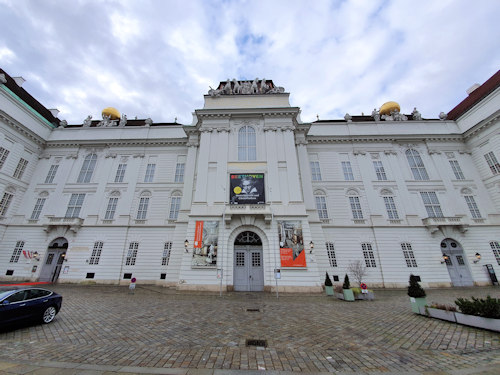
(Don’t miss a library trip. Trust me on this)
The central element of the Josefsplatz façade hides the former court library (now the National Library) and provides access to one of Vienna’s greatest treasures.
This part of today’s Hofburg complex dates back to the 1720s. Go through the Josefsplatz entrance to reach the 80m-long State Hall or Prunksaal, an opulent library room that just about out-Baroques anywhere else in a city of Baroque masterpieces.
Imagine the kind of frescoed ceiling, tall bookcases, gilt-topped columns, ancient globes, statues, and leather-bound tomes Disney might try to create. Then turn up the dial of awesomeness another couple of notches.
As a bonus, the Prunksaal usually has a special exhibition going on inside, too.
Hofburg
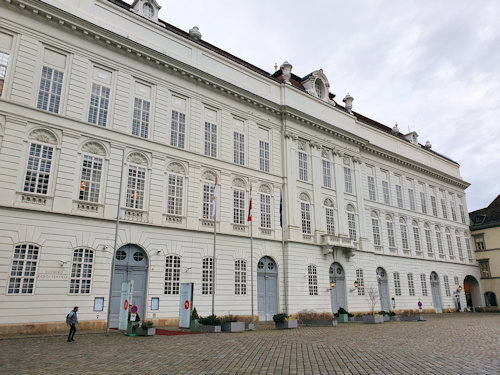
(A wing of the former Hofburg imperial complex)
The final part of that continuous façade, opposite the Augustinerkirche, forms part of the Hofburg proper and houses the Redoutensäle: two halls that essentially served as event venues. (And still do.)
Over their roughly 400 year history (with occasional redevelopment due to fire damage), the Redoutensäle have hosted plays, operas, masked balls, concerts (by the likes of Brahms and Liszt), banquets, and exhibitions.
In 1979, the USA’s Jimmy Carter and the Soviet Union’s Leonid Brezhnev signed the Salt II international arms treaty in the larger hall.
Incidentally, in 1760, our old friend Joseph II had his wedding banquet in the smaller hall.
The Stallburg
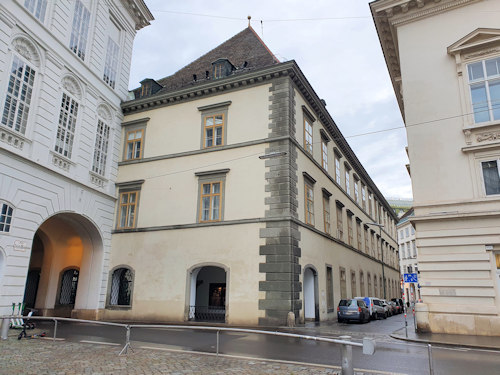
(A Renaissance corner to the square)
Not really part of Josefsplatz, but on the other side of the road from the Redoutensäle you can spot the corner of the Stallburg, a Renaissance building resonant with history.
The Lipizzaner stallions of the Spanish Riding School live inside and court horses have done so since the 1560s (!), which adds up to an awful lot of horse manure.
I recommend taking the stable and arena tour to view the interior and get up close to the magnificent white stallions.
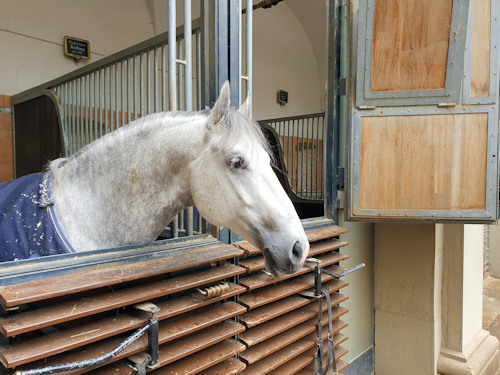
(Take a tour of the stables to see the lovely horses)
The Stallburg buildings often served additional purposes, though.
For example, in the 17th and 18th century, the floor above the stables held the imperial collection of paintings (now largely in the Kunsthistorisches Museum picture gallery).
The other end of the Stallburg appeared in the film, The Third Man. As did Josefsplatz itself, particularly our final location.
Palais Pallavicini & Palais Pálffy
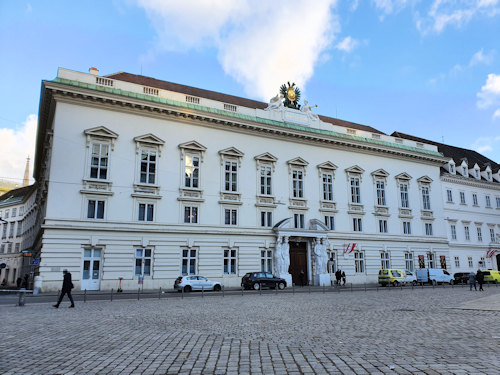
(Front view of Palais Pallavicini)
The two remaining buildings on our tour of Josefsplatz are both of the palais variety.
Palais Pallavicini at number 5 went up in the 1780s, so aptly illustrates the transition between the Baroque/Rococo and the more classical architectural style that succeeded them.
The Palais famously served as Harry Lime’s apartment in The Third Man and (spoiler alert) his “fatal” road accident took place immediately outside. A scene in the popular Vienna Blood TV drama also plays out on the rooftop.
The state rooms within retain their historical splendour and serve, like so many such locations, as a prestigious event venue.
Apart from the movie connection, the Palais enjoys additional enduring fame thanks to the entranceway. As you can imagine, the scantily-clad female figures that flank the portal raised a few eyebrows back in the day.
The sculptor behind those caryatids has his own connection to Josefsplatz: one of Franz Anton Zauner’s other works is that monument to Joseph II on the other side of the road.
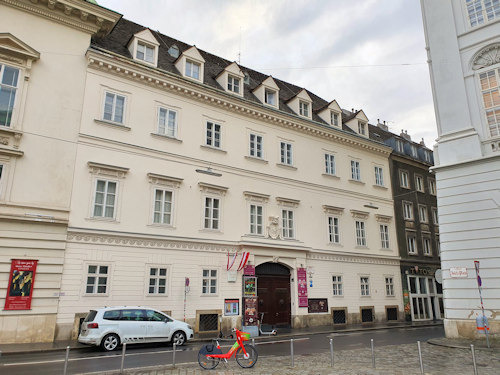
(Front view of Palais Pálffy)
The address at number 6 is Palais Pálffy, which harks back to the late 1500s. Unfortunately, WWII left its mark on the Renaissance building, although they did reconstruct the façade in all its glory.
How to get to Josefsplatz
If you’re exploring the historical highlights of old Vienna on foot, you’ll probably walk past anyway. Josefsplatz sits comfortably between the main Hofburg buildings and the famous Albertina art museum.
Subway: a short walk from the Herrengasse station (U3 subway line) or Stephansplatz station (U3 and U1 lines)
Tram/bus: the 1A and 2A old town buses stop nearby at Michaelerplatz or Habsburgergasse.
Address: Josefsplatz, 1010 Vienna